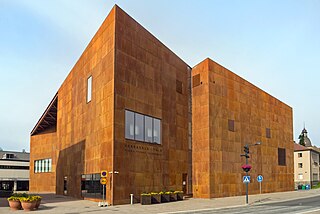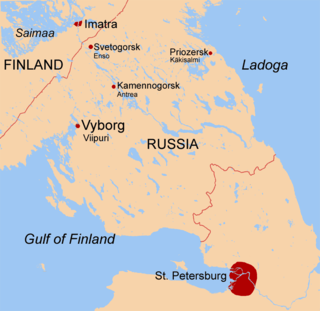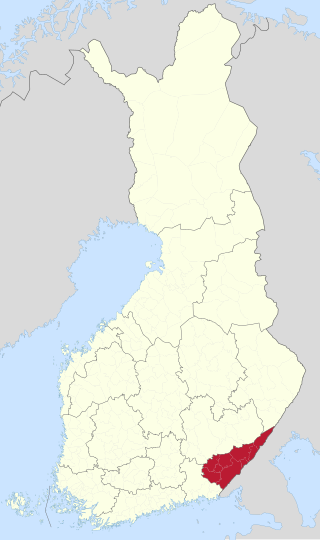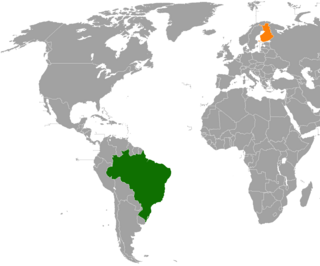
Lake Ladoga is a freshwater lake located in the Republic of Karelia and Leningrad Oblast in northwestern Russia, in the vicinity of Saint Petersburg.

Kangasala is a city in Finland, which is situated about 16 kilometres east of Tampere. The city was founded in 1865 and had a population of 33,352 people as of 19 September 2023. Kangasala covers an area of 870.86 km2 (336.24 sq mi) of which 212.83 km2 (82.17 sq mi) is water. The population density is 50.69 inhabitants per square kilometre (131.3/sq mi).

The Karelian Isthmus is the approximately 45–110-kilometre-wide (30–70 mi) stretch of land, situated between the Gulf of Finland and Lake Ladoga in northwestern Russia, to the north of the River Neva. Its northwestern boundary is a line from the Bay of Vyborg to the westernmost point of Lake Ladoga, Pekonlahti. If the Karelian Isthmus is defined as the entire territory of present-day Saint Petersburg and Leningrad Oblast to the north of the Neva and also a tiny part of the Republic of Karelia, the area of the isthmus is about 15,000 km2 (5,800 sq mi).

Imatra is a town and municipality in southeastern Finland. Imatra is dominated by Lake Saimaa, the Vuoksi River and the border with Russia. On the other side of the border, seven kilometres (4.3 mi) away from the centre of Imatra, lies the Russian town of Svetogorsk. The city of St. Petersburg is situated 210 km (130 mi) to the southeast, Finland's capital Helsinki is 230 km (140 mi) away and Lappeenranta, the nearest Finnish town, is 37 km (23 mi) away. Imatra belongs to the administrative province of Southern Finland and the region of South Karelia.

Lappeenranta is a city and municipality in the region of South Karelia, about 30 kilometres from the Russian border and 64 kilometres (40 mi) from the town of Vyborg (Viipuri). It is situated on the shore of the Lake Saimaa in southeastern Finland, and is one of the most significant urban centers in the whole Saimaa region, along with the towns of Imatra, Mikkeli and Savonlinna. With approximately 73,000 inhabitants Lappeenranta is the 13th largest city in Finland, after incorporating the previous municipalities of Lappee and Lauritsala in 1967, Nuijamaa in 1989, Joutseno in 2009, and Ylämaa in 2010.

Saimaa is a lake located in the Finnish Lakeland area in southeastern Finland. At approximately 4,279 square kilometres (1,652 sq mi), it is the largest lake in Finland, and the fourth-largest natural freshwater lake in Europe.

Vyborg Bay is a deep inlet running northeastward near the eastern end of Gulf of Finland in the Baltic Sea. The city of Vyborg is located near the head of the gulf.

The Vuoksi is a river running through the northernmost part of the Karelian Isthmus from Lake Saimaa in southeastern Finland to Lake Ladoga in northwestern Russia. The river enters Lake Ladoga in three branches, an older main northern branch at Priozersk (Käkisalmi), a smaller branch a few kilometers to the north of it, and a new southern branch entering 50 kilometers (31 mi) further southeast as Burnaya River, which has become the main stream in terms of water discharge. Since 1857, the old northern distributaries drain only the lower reaches of the Vuoksi basin and are not fed by Lake Saimaa. The northern and southern branches actually belong to two separate river systems, which at times get isolated from each other in dry seasons.

South Karelia is a region of Finland. It borders the regions of Kymenlaakso, South Savo and North Karelia, as well as Russia.

Karelia is an area in Northern Europe of historical significance for Russia, Finland, and Sweden. It is currently divided between northwestern Russia and Finland.

Joutseno is a former town and municipality of Finland. It is located in the province of Southern Finland and is part of the South Karelia region.

Pielinen is the fourth largest lake of Finland, with a drainage basin area of 12,823 km2 (4,951 sq mi) equally distributed between eastern Finland and Russia. The creation of the lake and its outlet is attributed to a post-glacial isostatic rebound, which resulted in uplift of the land. As is common in Finnish lakes, the lake's color is dark, due to the high proportion of bogs present in the catchment of the drainage basin that drains humic substances.

The Quinta da Boa Vista is a public park of great historical importance located in the São Cristóvão neighbourhood, in the North zone of the city of Rio de Janeiro, Brazil. The park was part of the gardens of the São Cristóvão Palace, the residence of the King of Portugal and then the Emperors of Brazil in the 19th century and the home of the Zoological Garden of Rio de Janeiro, with over 2000 species of animals. The building of the old palace hosted the National Museum, with collections on natural history, ethnology and archaeology.

Kuopio Airport is an airport in Rissala, Siilinjärvi, Finland, about 14 kilometres (9 mi) north of Kuopio city centre. It is the fifth busiest airport in Finland, as measured by the number of passengers, approximately 235,000 in 2017.

Finnish Lakeland or Finnish lake district is the largest of the four landscape regions into which the geography of Finland is divided.

Brazil–Finland relations are the diplomatic relations between the Federative Republic of Brazil and the Republic of Finland. Both nations are members of the United Nations.

Suvorov military canals is a series of four open canals on Saimaa lake in Finland. The four canals of Kutvele, Käyhkää, Kukonharju and Telataipale are located in Puumala, Ruokolahti and Sulkava. They were built between 1791 and 1798 as part of the South-Eastern Finland fortification system and are the oldest canals in Finland. The canals are named after general Alexander Suvorov who ordered their construction.

Kermajärvi is a medium-sized lake in the Vuoksi main catchment area. It is located in the region of Southern Savonia in Heinävesi. It is the country's 53rd largest lake with an area of 85.57 square kilometres (33.04 sq mi) and consists of a wide open lake with plenty of islands in both northwest and southeast parts of it and several long, narrow bays in both ends.

Visulahti is a dinosaur themed amusement park and tourist center opened in 1980 in Mikkeli, Finland, along the Lake Saimaa and the Kuopio Highway. It is similar to Tervakoski's Puuhamaa as there are no traditional amusement park equipment. It consists of three areas: Dinosauria, HyperDino and Visulahti Wax Cabinet. The Dinosauria has two different swimming pools and three large water slides. Visulahti also has accommodation and a camping site. Visulahti is owned by the Spanish Aspro Ocio S.A. through Puuharyhmä Oyj, which it acquired in 2007.























